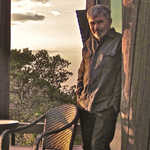Dear Lorien,
The photo above is the view as we headed in to Kahului town this morning, via the airport road. That’s a Costco gas station in the foreground—a new one, Lloyd says, and one desperately needed around here, as gas is very expensive on Maui. In the background you see the West Maui Mountains, with the homes at Wailuku Heights clustered on the mountains’ lower reaches.
 Lloyd is heading in to Iao Church to pick something up for Pastor Belsom, whose day off it is today. Then he plans to show me Iao Valley, a lush and wet tropical haven (it’s that one on the right side, in the distance). He says it will be quite different from the beaches and sugarcane fields I’ve been to so far. Here I am on the sign at the fork in the road leading in to Iao. This is in Wailuku town, at mile marker 0 (Wailuku is the county seat, and City Hall is right across the street facing the sign).
Lloyd is heading in to Iao Church to pick something up for Pastor Belsom, whose day off it is today. Then he plans to show me Iao Valley, a lush and wet tropical haven (it’s that one on the right side, in the distance). He says it will be quite different from the beaches and sugarcane fields I’ve been to so far. Here I am on the sign at the fork in the road leading in to Iao. This is in Wailuku town, at mile marker 0 (Wailuku is the county seat, and City Hall is right across the street facing the sign).
[ Later… ]
 We drove along the winding road through the valley, and it was showering off an on, as it usually does here, so Lloyd says. And then we stopped here where the light rain had eased off for a bit, to capture the lush green and steep walls of the surrounding cliffs. If you click on any of these photos you will get to a page where Lloyd has posted more of them, starring … me! :-)
We drove along the winding road through the valley, and it was showering off an on, as it usually does here, so Lloyd says. And then we stopped here where the light rain had eased off for a bit, to capture the lush green and steep walls of the surrounding cliffs. If you click on any of these photos you will get to a page where Lloyd has posted more of them, starring … me! :-)
Iao Valley is famous in ancient Hawaiian history for an important battle that took place here. In the late 1700s, King Kamehameha I, who lived in the island of Hawaii (the nickname of which is the “Big Island” nowadays) decided to unite all the islands in the archipelago, each of which had its own kings. At the tourist center inside the valley, there is a sign that tells of this battle. It reads:
In 1790, Kamehameha I landed along Kahului Bay with a large fleet of canoes. At Wailuku, Kamehameha’s forces met the Maui forces under Kalaniku ūpule. Kalanikūpule was placed in charge while his father, ruling chief Kahekili, was living on O’ahu after defeating the O’ahu forces in 1783.
This battle for Maui is said to be one of the most bitter fought on Hawaiian soil. As the warriors reached Iao, their shouts of defiance echoed throughout the valley. Women and children on the mountainsides were witnesses to the clashing of wooden spears, the firing of muskets, and the roar of the cannon. There were so many slain from both armies that their bodies clogged the stream. Thus, the battle was named Kepaniwai or “damming of the waters.”
Lloyd tells me that whenever he ventures deep into Iao Valley for a hike, he always gets a tingly sense that he is being watched; perhaps by ghosts of the long-dead warriors of Kamehameha and Kalanikūpule. I didn’t spend enough time in this valley today to get this sense.
 Instead, I was overwhelmed with how green everything was, and how steep were the walls of the mountain on both sides of the valley, below which was a rock-filled stream. Here I am, ensconced inside the folds of a large leafy plant, enjoying the aura of the day in this verdant, tropical valley. I wanted to jump in and swim in the clear pools found amid the rocky stream, but that would surely mean I’d get wet and moldy, or even disintegrate entirely. Next time, make me out of plastic or some other water-resistant material. :-)
Instead, I was overwhelmed with how green everything was, and how steep were the walls of the mountain on both sides of the valley, below which was a rock-filled stream. Here I am, ensconced inside the folds of a large leafy plant, enjoying the aura of the day in this verdant, tropical valley. I wanted to jump in and swim in the clear pools found amid the rocky stream, but that would surely mean I’d get wet and moldy, or even disintegrate entirely. Next time, make me out of plastic or some other water-resistant material. :-)
your friend,
Flat Stanley
Other moments in Wailuku
-
Forests always have stories...
in Wailuku, United States -
sky, Thoughts
Sunrise, and one reason to stay :-)
in Wailuku, United States -
Into the vast unknown...
in Wailuku, United States -
sunsets
Tendrils of plant and cloud herald the day.
in Wailuku, United States -
Beaches, sunrise
Where I met sunrise this morning at Waiehu Beach I found this overnight mandala alone, totemic, intimating impermanence.
in Wailuku, United States -
Epic Views
The moment she burst forth and the stunning, massive shadow she cast on the lower flanks of the volcano...
in Wailuku, United States -
Epic Views, nature
This one will require comment.
in Wailuku, United States -
sunrise, Volcanoes
Before sunrise, Wailuku Heights. Catching the sharp, sensual curve of Haleakala Volcano.
in Wailuku, United States -
At 6:07 this morning, sunrise. And news of an earthquake in Northern California, where I used to live.
in Wailuku, United States





